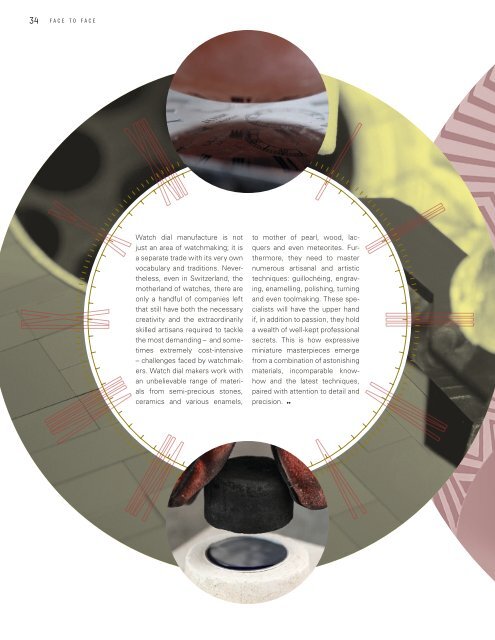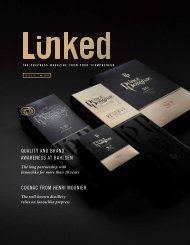Janoschka magazine Linked_V8_2023
The customer magazine by Janoschka and Linked2Brands.
The customer magazine by Janoschka and Linked2Brands.
Create successful ePaper yourself
Turn your PDF publications into a flip-book with our unique Google optimized e-Paper software.
34 f a c e t o f a c e<br />
issue #8 © l i n k e d 35<br />
Thh e divisions on a watch dial allow us to measure time precisely down to fractions of a second. Th h e indices, windows and sub-dials allow us to keep an eye on the time, day, date, month and year as well as follow the phases of the moon.<br />
METICULOUS CARE<br />
Watch dial manufacture is not<br />
just an area of watchmaking; it is<br />
a separate trade with its very own<br />
vocabulary and traditions. Nevertheless,<br />
even in Switzerland, the<br />
motherland of watches, there are<br />
only a handful of companies left<br />
that still have both the necessary<br />
creativity and the extraordinarily<br />
skilled artisans required to tackle<br />
the most demanding – and sometimes<br />
extremely cost-intensive<br />
– challenges faced by watchmakers.<br />
Watch dial makers work with<br />
an unbelievable range of materials<br />
from semi-precious stones,<br />
ceramics and various enamels,<br />
to mother of pearl, wood, lacquers<br />
and even meteorites. Furthermore,<br />
they need to master<br />
numerous artisanal and artistic<br />
techniques: guillochéing, engraving,<br />
enamelling, polishing, turning<br />
and even toolmaking. These specialists<br />
will have the upper hand<br />
if, in addition to passion, they hold<br />
a wealth of well-kept professional<br />
secrets. This is how expressive<br />
miniature masterpieces emerge<br />
from a combination of astonishing<br />
materials, incomparable knowhow<br />
and the latest techniques,<br />
paired with attention to detail and<br />
precision.<br />
Each watch dial model is unique and<br />
defined by its style, functions and<br />
components, like date display, totalisators<br />
(sub-dials), moon phase indicators<br />
– and the way these are positioned.<br />
Once the design has been finalised,<br />
the dial-maker starts with a blank: a<br />
thin metal disc made from brass, nickel,<br />
gold, silver, titanium or similar. After<br />
a few preparations, which include<br />
punching out the display windows and<br />
the hole in the centre for the hands,<br />
they attach small feet to the back of<br />
the metal disc. These appendages<br />
eventually anchor the watch face to<br />
the movement. Initially, though, their<br />
job is to ensure accurate positioning<br />
of the dial during the subsequent assembly<br />
stages. The blanks are then<br />
cleaned and polished before setting<br />
out on a journey into a world of diverse<br />
and highly specialised craftsmanship.<br />
Along the way, some will be adorned<br />
with decorative finishes (like the famous<br />
sunbrushing); others may stop<br />
off at the electroplating department<br />
for metal-plated enhancements; while<br />
others still will receive their final colour<br />
in the paint shop.<br />
Let’s take a closer look at a few special<br />
surface refinements. Some have<br />
been used for centuries, while others<br />
are state-of-the-art. Meticulous craftsmanship<br />
is involved as well as the<br />
latest advanced precision tools. Both<br />
serve to produce watch dials with a<br />
perfect balance of beauty and clear<br />
readability.









